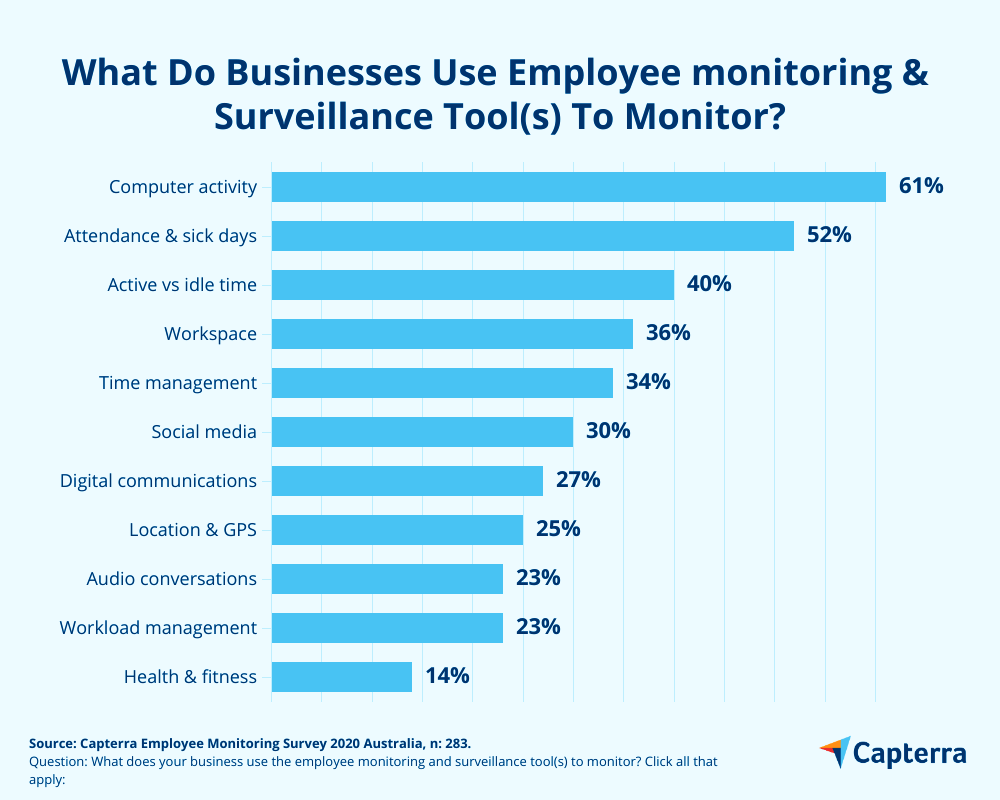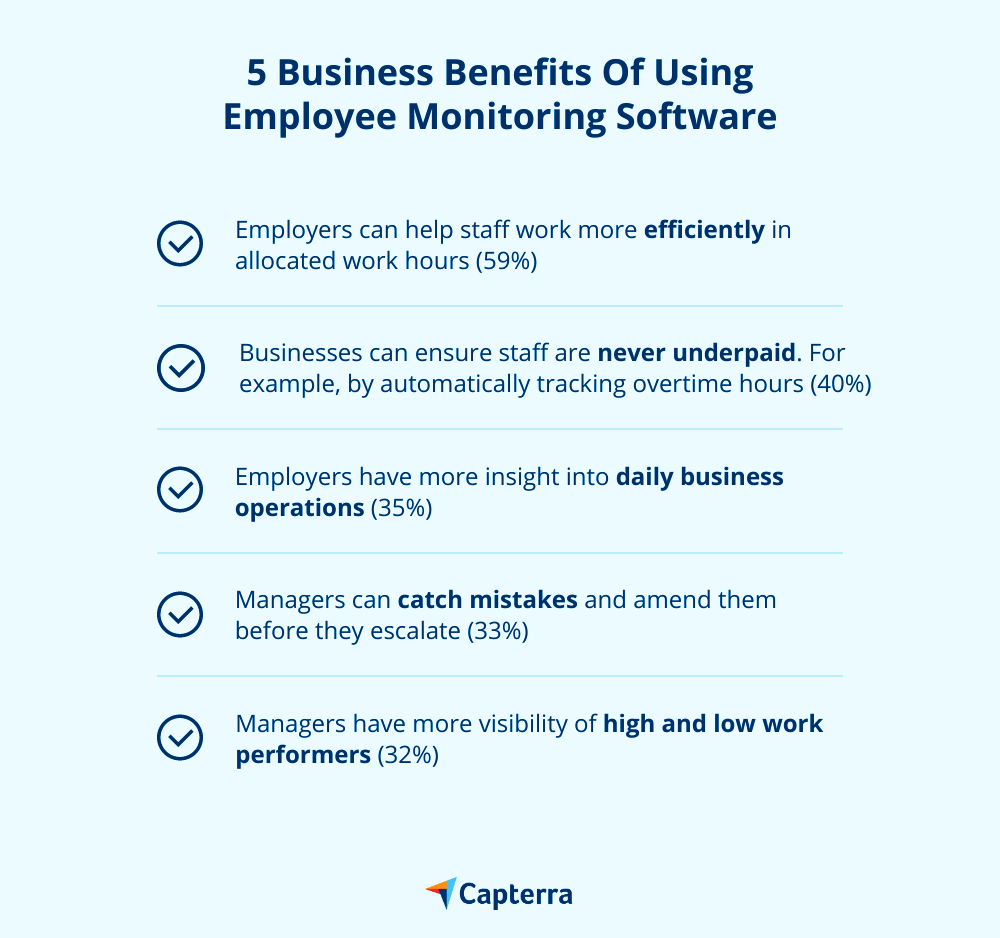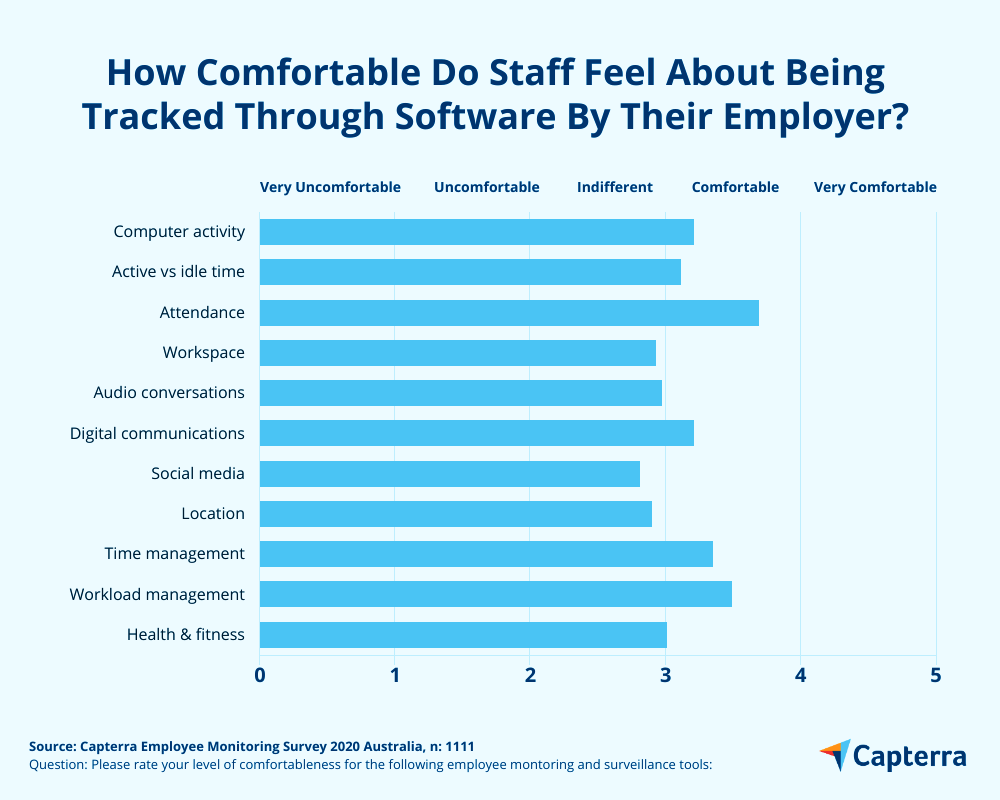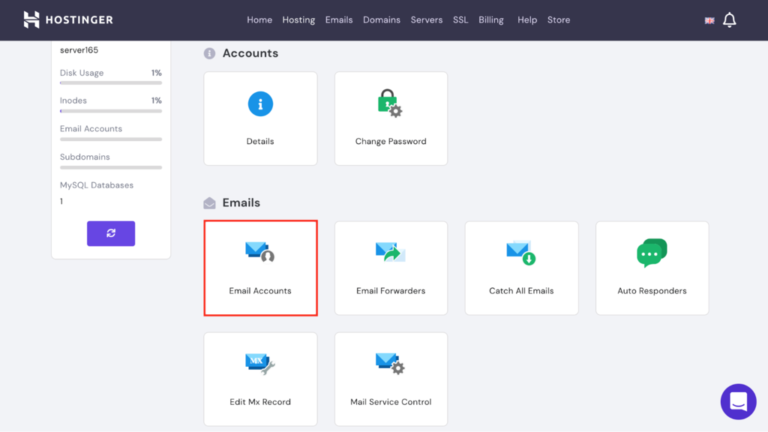When Australia first went into a lockdown in March 2020, it was unclear how businesses would cope. To many, working from home full-time was a brand new concept. One key area of concern was how administrators and supervisors would manage their staff without being under the same roof.

In this article, we explore how using tracking and surveillance software plays an important role in the relationships between employers and their managers.
But first, let’s go over some of the basics of what employee monitoring is, and the rules around what businesses can and can’t track.
What is employee monitoring?
Employee monitoring is the process by which a business tracks its staff’s work activities. Through software, companies can measure elements such as productivity, efficiency, and security. This data gives them a greater understanding of areas where they’re thriving as well as the ones which require attention.
An employee monitoring system also looks at how staff engage with individual and corporate goals. On top of that, it covers some basic HR (human resource) aspects, like tracking attendance and sick days.
Is employee monitoring legal in Australia?
Yes, employee monitoring is legal in Australia. However, the law permits that employers can’t do so without informing their staff. There are some exceptions to the rule—but this is rare and to do so would require a “covert surveillance authority” from a Magistrate.
In most cases, however, employers must inform staff members that tracking or surveillance software has been installed or activated on their work devices within 14 days of doing so. This includes the tracking of:
- User activity: Computer monitoring, internet access, time-tracking, web browsing.
- Active vs idle time: Mouse movements, keystroke logging (the action of recording the keys struck on a keyboard), login/log out time.
- Attendance: Login/log out time, active/idle time, attendance, sick days.
- Workspaces: Using webcams & video surveillance to take time-lapse photos or screenshots.
- Audio conversations: Phone use.
- Digital communications: Emails, instant chat, video conference.
- Social media: Personal account use.
- Location: Vehicle & GPS tracking.
- Time management: Total time spent on individual tasks, time spent on projects, work calendar.
- Workload management: Action lists, work schedule, goal metrics & KPIs (key performance indicators.)
- Health & fitness: Wearable technologies to track physical wellbeing.
It’s important that employers explain exactly what they’re monitoring, and in a way that is easy to understand. For some areas, such as tracking staff’s internet and social media activities, employers should create clear policies to help increase awareness.
The current state of employee tracking in Australian SMEs
Many small and medium-sized businesses in Australia leapt forward in terms of digital transformation in 2020. Part of this was learning how to operate digitally with a distributed workforce and remote working software.
Capterra wanted to understand how the transition to remote work had impacted work relationships within Australian SMEs. We surveyed 1,400 Australian professionals about managerial relationships within their business; 20% of responses came from business and department leaders. *To see a detailed methodology of the survey, skip to the bottom of this article.
Key employee monitoring statistics
1. 59% of business leaders surveyed use tools to monitor their employees
While the majority (59%) of business leaders said they use an employee monitoring software, only 15% said they introduced the software after COVID-19 restrictions came in. This suggests that businesses saw employee monitoring software as a valuable business asset before companies began operating remotely full-time.
Tracking computer activity is the most common forms of surveillance
Monitoring staff’s computer activity, such as internet access, time-tracking and web browsing, is the most common employee monitoring solution.

In recent years, wearable technologies (such as smartwatches and fitness-tracking bands) have made their way into the workplace. The idea is to promote healthier lifestyle choices and improve health. In turn, this should improve employee productivity, because according to Corporate Wellness Magazine, ‘a healthy employee is more likely to be productive than an unhealthy one.’
Despite this, only 14% of business leaders are following this trend, with health & fitness tracking proving to be the least popular form of surveillance.
2. 73% of leaders believe tracking software has a positive impact on their business
Almost three quarters (73%) of business leaders from the survey said that they had seen some positive impacts of using employee monitoring software.

Around a quarter (24%) of business leaders also referenced the benefit of having greater visibility over HR issues, like workplace bullying or harassment.
Increased business security was another benefit noted by 28% of leaders surveyed. Given the potential threats of cybercrime (of which SMEs are the biggest target), there is a genuine need for businesses to keep a close eye on whether staff are following security measures. Activity monitoring also enables companies to protect themselves against insider threats (like data breaches) and track how employees store sensitive data.
More than three quarters (79%) of business owners who use employee tracking software say they plan to continue investing in it.
3. 54% of employees believe tracking software can have a negative impact
Staff aren’t as enthusiastic as their leaders and management team are about tracking software. Just 28% of employees surveyed said it has a positive impact while 54% said the opposite.
Employees are mostly indifferent or comfortable with tracking software
In general, 18% of the employees surveyed are indifferent about being monitored via software. This trend was evident across almost all areas of employee monitoring.

4. Deflated morale, increased stress, and work-life balance is a concern
Even though employees weren’t objecting to the use of their manager using software to track them, they did flag some concerns:
Employee morale
46% of respondents said knowing they’re being monitored (actually or hypothetically) would have no impact on how hard they work. In terms of motivation, 39% said it had or would have no impact. However, despite this, 42% of respondents expressed a concern around employee monitoring hurting trust levels within the business. Similarly, 44% of respondents said the software deflates morale.
Increased stress
There were also some important differences in behaviour from the respondents who said they are tracked versus those that aren’t:
- 37% of employees who aren’t monitored through software say they feel very comfortable to take their entitled breaks
- 26% of employees who are tracked said the same.
Overall, 46% of respondents said they feel concerned about the software contributing to increased stress from staff.
Prolonged pressure to work outside of contract hours
Employees who are monitored are also less comfortable ending their workday—28% of employees who are tracked said they’re very comfortable with leaving at the end of the day. However, this is less than unmonitored employees, 38% of respondents from this demographic said the same.
This feeling of being watched may put undue pressure on staff and create a culture of poor work-life balance. To avoid this, employers must actively keep an eye on their staff’s working hours to prevent further issues, like staff burnout.
Ironically, using monitoring tools (such as time tracking software) is one way to learn how much work employees can achieve within their contracted hours. However, it’s important that managers explain the purpose behind the software usage.
How employers can get staff on board with tracking tools
The survey highlights that business leaders may be using employee monitoring software with good intentions, but there is a clear elephant in the room: Employees don’t like it.
While the survey demonstrated that most employees aren’t putting up any form of resistance towards being tracked via software—they don’t necessarily see the value in it. This is where employers could do more to get their staff’s buy-in. Providing greater insight into how software is beneficial to employees may relieve some anxiety and lead to greater acceptance.
Survey methodology: Employee Monitoring Survey 2020 Australia, 09/11/2020.
Capterra conducted this survey in October 2020 of 1,400 respondents to learn more about how employee monitoring software affects the relationships between managers and employees. To qualify for this survey, respondents had to be employees of an Australian small or medium-sized business.



![Apex Legends Octane guide [Season 7]: abilities, hitbox, tips and tricks](https://tomeraider.com/wp-content/uploads/2020/11/apex-legends-octane-guide-season-7-abilities-hitbox-tips-and-tricks.jpg)

